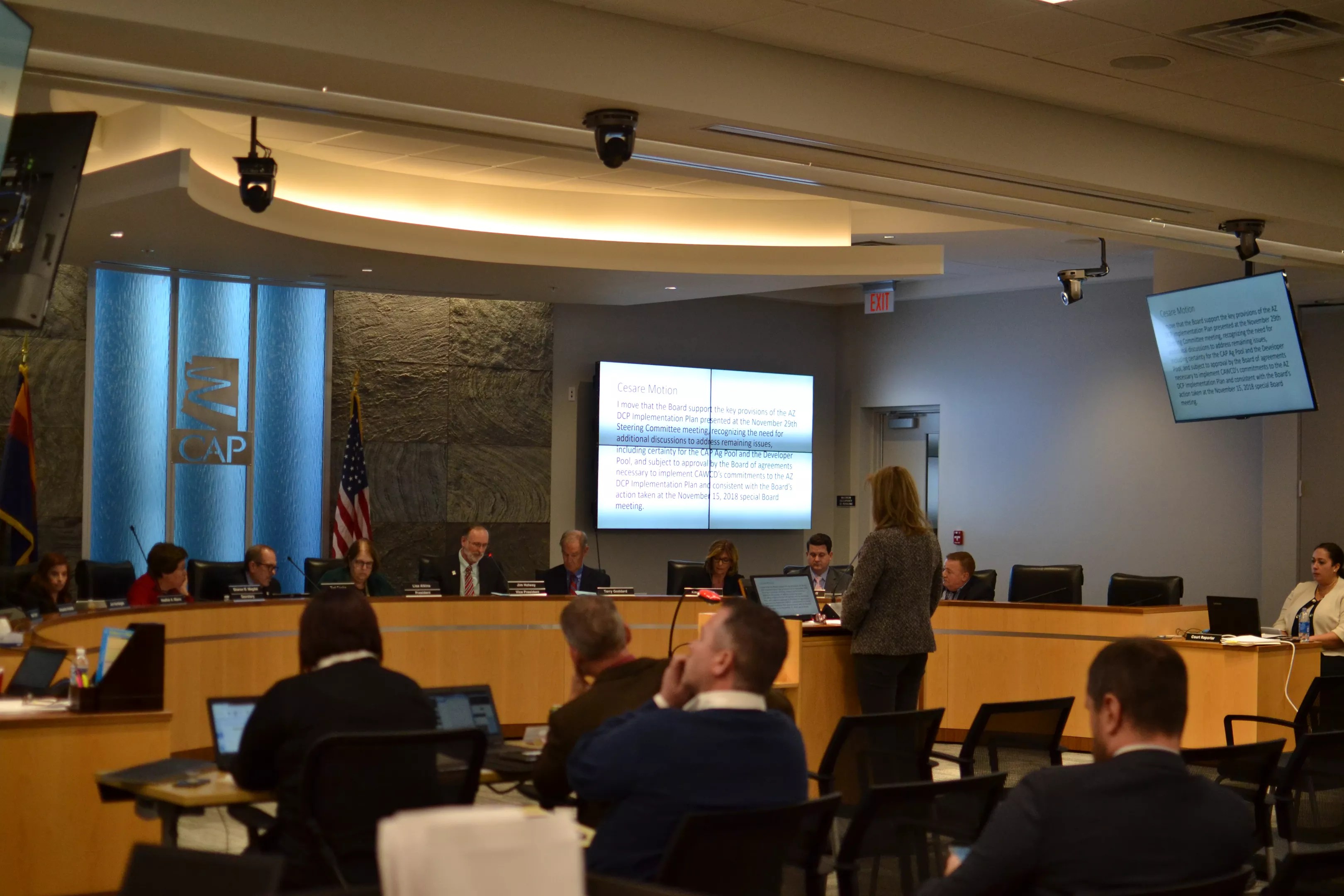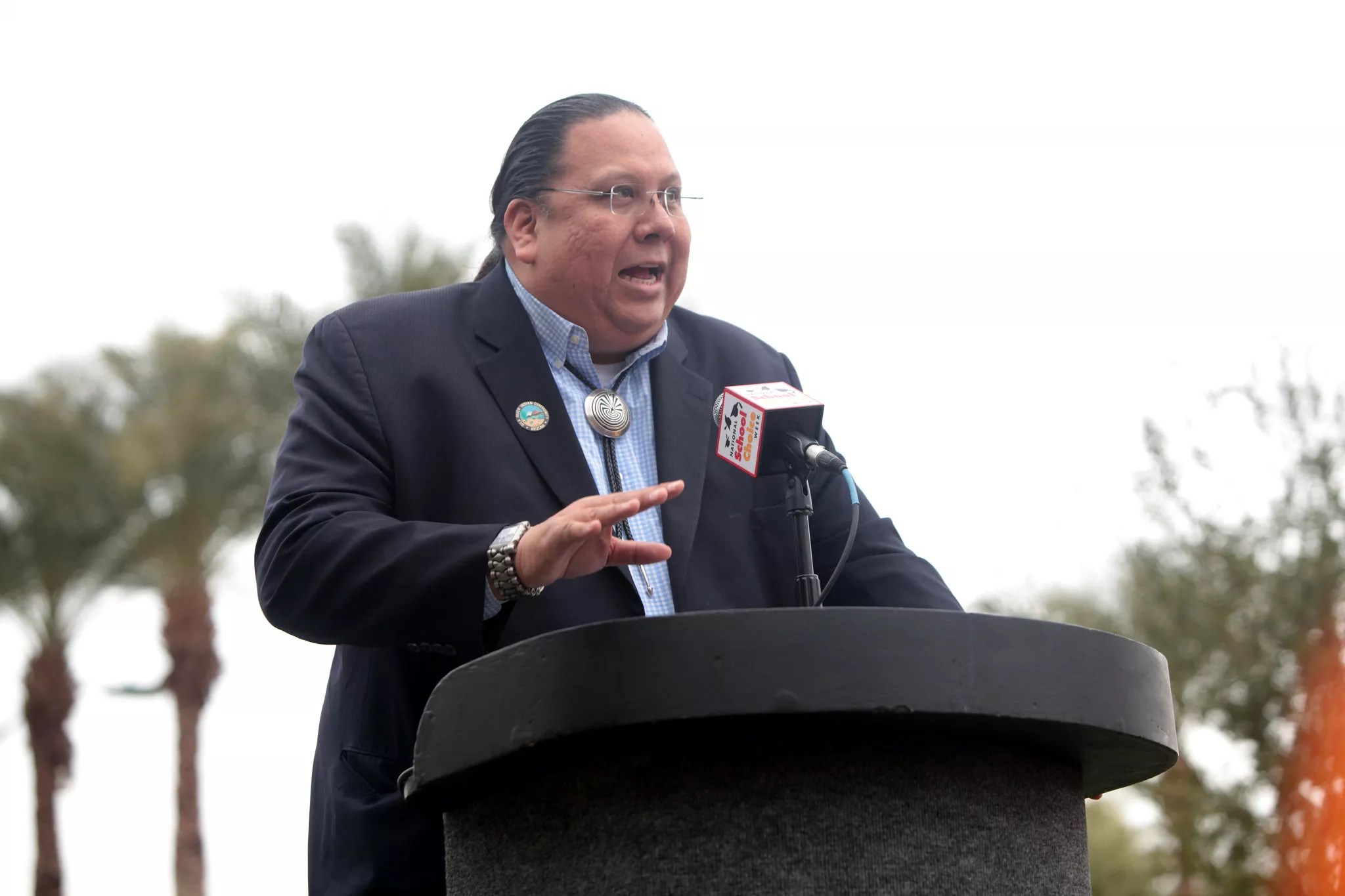
Elizabeth Whitman/Phoenix New Times

Audio By Carbonatix
The board of the Central Arizona Project voted on Thursday to help finalize a Drought Contingency Plan for the state of Arizona, and it relented somewhat on the last serious sticking point in the talks – a demand to co-sign the plan with state authorities – as it approved the Lower Basin Drought Contingency Plan.
After months of contentious negotiations and stalled talks, these decisions smooth the way for the Arizona Legislature to approve a plan to stave off catastrophic shortages on the Colorado River. This plan specifies how Arizona will implement the multistate Lower Basin plan, which also includes Nevada and California.
The proposal, first made public during a Drought Contingency Plan Steering Committee meeting on November 29, lays out a broad framework for how Arizona water users would share cuts to their supply of Colorado River water during a shortage. According to federal projections, such a shortage is more likely than not to be declared in 2020.
Many details still have to be worked out, but the plan has garnered support from key stakeholders, including tribal communities, cities, and Governor Doug Ducey. After Thursday’s deal, developers seemed to be on board as well. Representatives of Pinal County agriculture, however, have hesitated to support it, given uncertainties in future funding.
Phoenix, make your New Year’s Resolution Count!
We’re $14,000 away from our End-of-Year campaign goal, with just a five days left! We’re ready to deliver — but we need the resources to do it right. If New Times matters to you, please contribute today to help us expand our current events coverage when it’s needed most.
The proposal was “a very creative endeavor,” Suzanne Ticknor, a senior attorney for the Central Arizona Project, said in summarizing it for the board during its monthly meeting on Thursday.
“This plan is amazing, actually, in that it accomplished putting together a package that was able to … ‘honor the yeses and honor the noes,'” Tom Buschatzke, director of the Arizona Department of Water Resources, said in his remarks, echoing a phrase that Ticknor used. “No small accomplishment.”
He and other leaders warned of the fragility of this progress, as if begging water user groups not to rock the boat. The provisions of the proposal fit together in such a way that “if one or two unravel, the whole thing will,” Buschatzke warned.
After several hours of discussion on the drought proposal, the board voted unanimously on a motion to support the key provisions of the November 29 plan, while “recognizing the need for additional discussions to address remaining issues.”
The afternoon talks were part of a marathon meeting on Thursday that dragged on well beyond the scheduled timeline. By mid-afternoon, one attendee had three cans of Mountain Dew and a candy bar wrapper in front of him; the woman beside him snacked on peanut M&Ms.

Gov. Stephen Roe Lewis of the Gila River Indian Community.
In their comments to the board, multiple stakeholders praised the CAP board for jump-starting the stalled drought plan negotiation process. The board put forward a bare-bones proposal during a special meeting in mid-November and authorized $60 million in funding to go toward a Drought Contingency Plan. Although that proposal was ultimately abandoned, it set the stage for the current proposal that now, finally, appears to be moving forward.
The vote comes a day after the advancement of a major deal between the Gila River Indian Community and its Gila River Water Storage, and the Central Arizona Groundwater Replenishment District (CAGRD). That deal, the final passage of which is contingent upon the signing of a Drought Contingency Plan, helped alleviate some of developers’ concerns about access to water for future economic development, should a shortage be declared.
“We now have a confirmed source of water to meet the needs of the development community for the next 25 years,” Governor Stephen Roe Lewis of the Gila River Indian Community said during Thursday’s meeting. “I am now authorized to sign the CAGRD deal as soon as the Arizona Legislature approves Governor Ducey’s DCP program.”
Like Buschatzke, Lewis hinted at the fragility of this proposal as stakeholders continue to sort out details. “This plan is a very delicate compromise,” he said. Any substantive change, he warned, “could be fatal.”
Spencer Kamps, the vice president of legislative affairs for the Home Builders Association of Central Arizona, thanked Lewis for the deal, although he said he would have preferred a deal that was “signed, sealed, delivered,” rather than one contingent upon legislative approval of a Drought Contingency Plan.
“We’re seeking … a message of certainty that regardless of what happens … Arizona has water for economic development through the GRD so that we can continue to grow,” Kamps said.
Terry Goddard, a CAP board member, asked Kamps, “So you’re saying the legislature is not predictable?”
“Yes,” Kamps responded. Nevertheless, he said the Home Builders Association supported the board’s motion to support the November 29 drought plan.
Advocates for farmers, however, remain critical of the proposal. Paul Orme, who represents Pinal County agriculture, said that under it, farmers would lose 60 percent of their surface water. “This is going to be painful for us,” he told the board.
“This plan is a very delicate compromise,” – Governor Stephen Roe Lewis, Gila River Indian Community
He said he had “concerns” about another major component of the proposal, which was that, in lieu of using Colorado River water, agricultural districts would develop infrastructure to access groundwater. That development would require federal funds, which he said could not be relied upon.
Farmers, Orme said, were already being asked to put up $12 million for that plan. “And that’s just not gonna cut it,” he added. “We need commitments from other folks.”
Assistance from the Central Arizona Project, he said, was “merited.”
The last major potential sticking point in Arizona’s drought negotiations – a demand by the CAP board to co-sign the Lower Basin plan, along with the state – appeared to be resolved, or at least tabled, on Thursday, with a bit of legal maneuvering.
It wasn’t immediately clear how that would work, as the board entered private session with lawyers to discuss the issue. However, the board unanimously approved a motion to approve the Lower Basin agreements, and to authorize its president to execute them, “provided those documents protect the board’s capacity to enforce all parties’ obligations under the DCP, in court if necessary.”
Buschatzke, the ADWR director, who has the legal authority to sign the drought contingency plan, responded vaguely, if positively.
“My attorneys haven’t had the chance to analyze this in any level of detail,” Buschatzke told the board. But, he allowed, “It seems like we have the ability to continue the good faith efforts and honest discussion that have taken place on this issue.”
“I’m hopeful this might be a path forward,” he said.